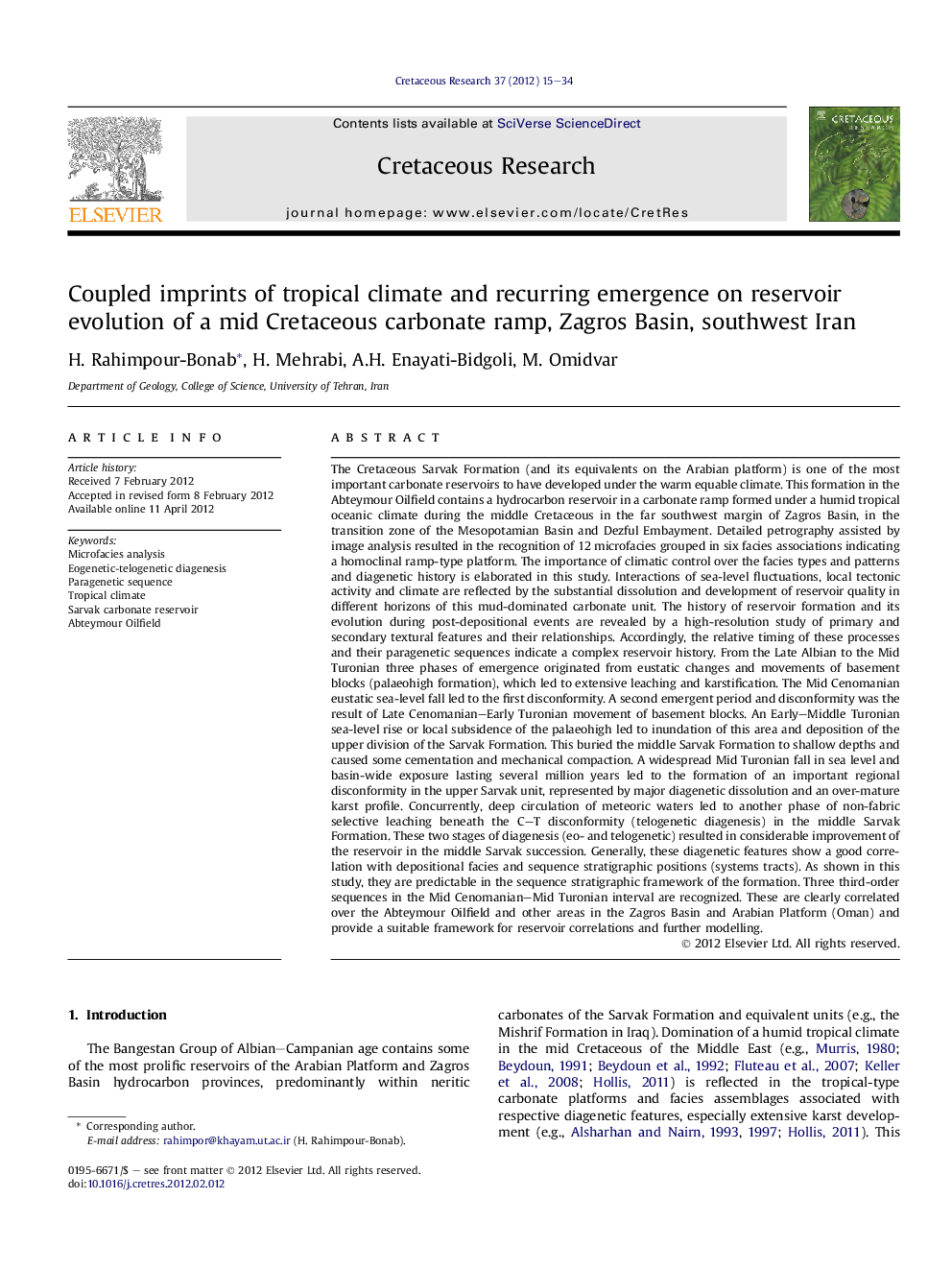| کد مقاله | کد نشریه | سال انتشار | مقاله انگلیسی | نسخه تمام متن |
|---|---|---|---|---|
| 6448341 | 1642085 | 2012 | 20 صفحه PDF | دانلود رایگان |
عنوان انگلیسی مقاله ISI
Coupled imprints of tropical climate and recurring emergence on reservoir evolution of a mid Cretaceous carbonate ramp, Zagros Basin, southwest Iran
دانلود مقاله + سفارش ترجمه
دانلود مقاله ISI انگلیسی
رایگان برای ایرانیان
موضوعات مرتبط
مهندسی و علوم پایه
علوم زمین و سیارات
فسیل شناسی
پیش نمایش صفحه اول مقاله

چکیده انگلیسی
The Cretaceous Sarvak Formation (and its equivalents on the Arabian platform) is one of the most important carbonate reservoirs to have developed under the warm equable climate. This formation in the Abteymour Oilfield contains a hydrocarbon reservoir in a carbonate ramp formed under a humid tropical oceanic climate during the middle Cretaceous in the far southwest margin of Zagros Basin, in the transition zone of the Mesopotamian Basin and Dezful Embayment. Detailed petrography assisted by image analysis resulted in the recognition of 12 microfacies grouped in six facies associations indicating a homoclinal ramp-type platform. The importance of climatic control over the facies types and patterns and diagenetic history is elaborated in this study. Interactions of sea-level fluctuations, local tectonic activity and climate are reflected by the substantial dissolution and development of reservoir quality in different horizons of this mud-dominated carbonate unit. The history of reservoir formation and its evolution during post-depositional events are revealed by a high-resolution study of primary and secondary textural features and their relationships. Accordingly, the relative timing of these processes and their paragenetic sequences indicate a complex reservoir history. From the Late Albian to the Mid Turonian three phases of emergence originated from eustatic changes and movements of basement blocks (palaeohigh formation), which led to extensive leaching and karstification. The Mid Cenomanian eustatic sea-level fall led to the first disconformity. A second emergent period and disconformity was the result of Late Cenomanian-Early Turonian movement of basement blocks. An Early-Middle Turonian sea-level rise or local subsidence of the palaeohigh led to inundation of this area and deposition of the upper division of the Sarvak Formation. This buried the middle Sarvak Formation to shallow depths and caused some cementation and mechanical compaction. A widespread Mid Turonian fall in sea level and basin-wide exposure lasting several million years led to the formation of an important regional disconformity in the upper Sarvak unit, represented by major diagenetic dissolution and an over-mature karst profile. Concurrently, deep circulation of meteoric waters led to another phase of non-fabric selective leaching beneath the C-T disconformity (telogenetic diagenesis) in the middle Sarvak Formation. These two stages of diagenesis (eo- and telogenetic) resulted in considerable improvement of the reservoir in the middle Sarvak succession. Generally, these diagenetic features show a good correlation with depositional facies and sequence stratigraphic positions (systems tracts). As shown in this study, they are predictable in the sequence stratigraphic framework of the formation. Three third-order sequences in the Mid Cenomanian-Mid Turonian interval are recognized. These are clearly correlated over the Abteymour Oilfield and other areas in the Zagros Basin and Arabian Platform (Oman) and provide a suitable framework for reservoir correlations and further modelling.
ناشر
Database: Elsevier - ScienceDirect (ساینس دایرکت)
Journal: Cretaceous Research - Volume 37, October 2012, Pages 15-34
Journal: Cretaceous Research - Volume 37, October 2012, Pages 15-34
نویسندگان
H. Rahimpour-Bonab, H. Mehrabi, A.H. Enayati-Bidgoli, M. Omidvar,